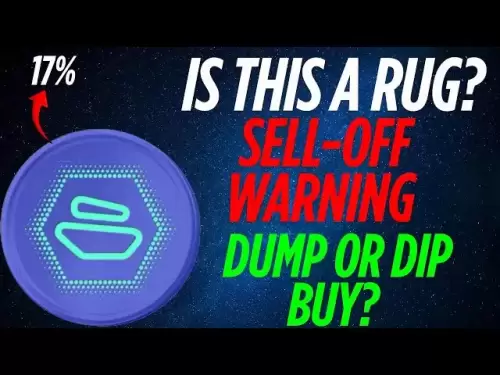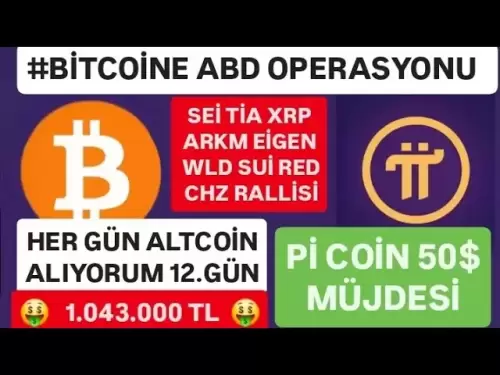-
 Bitcoin
Bitcoin $108,010.6153
-0.99% -
 Ethereum
Ethereum $2,535.1451
-1.14% -
 Tether USDt
Tether USDt $1.0002
-0.01% -
 XRP
XRP $2.2599
-0.33% -
 BNB
BNB $660.3442
-0.18% -
 Solana
Solana $149.0762
-1.43% -
 USDC
USDC $0.9999
0.00% -
 TRON
TRON $0.2866
-0.41% -
 Dogecoin
Dogecoin $0.1669
-2.73% -
 Cardano
Cardano $0.5765
-1.53% -
 Hyperliquid
Hyperliquid $38.5005
-2.98% -
 Bitcoin Cash
Bitcoin Cash $496.7709
-0.04% -
 Sui
Sui $2.8522
-2.12% -
 Chainlink
Chainlink $13.2812
-1.50% -
 UNUS SED LEO
UNUS SED LEO $9.0486
0.17% -
 Stellar
Stellar $0.2466
-2.57% -
 Avalanche
Avalanche $17.8271
-2.84% -
 Shiba Inu
Shiba Inu $0.0...01158
-1.66% -
 Toncoin
Toncoin $2.7359
-4.01% -
 Hedera
Hedera $0.1563
-1.78% -
 Litecoin
Litecoin $85.8096
-1.80% -
 Monero
Monero $313.7645
-2.86% -
 Dai
Dai $1.0002
0.02% -
 Polkadot
Polkadot $3.3494
-1.35% -
 Ethena USDe
Ethena USDe $1.0003
0.03% -
 Bitget Token
Bitget Token $4.2980
-3.40% -
 Uniswap
Uniswap $7.3906
-0.28% -
 Aave
Aave $280.1449
-2.34% -
 Pepe
Pepe $0.0...09833
-2.41% -
 Pi
Pi $0.4546
-2.21%
How to calculate the profit and loss of ADA trading?
Calculate ADA trading profits with: (Sale Price - Purchase Price) × Number of ADA. Don't forget transaction fees for accurate net profit or loss.
Apr 23, 2025 at 03:21 pm
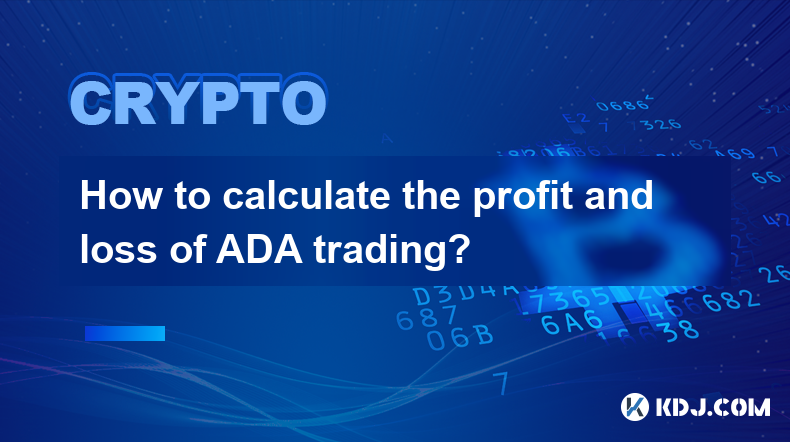
Trading Cardano (ADA) can be a lucrative venture, but it's crucial to understand how to calculate your profits and losses accurately. This guide will walk you through the steps to determine your financial performance when trading ADA, ensuring you have a clear picture of your investment's success.
Understanding the Basics of ADA Trading
Before diving into calculations, it's essential to understand some basic concepts. ADA is the native cryptocurrency of the Cardano blockchain, and its value fluctuates based on market demand and supply. When you buy ADA, you hope its value will increase, allowing you to sell it at a profit. Conversely, if the value decreases, you may incur a loss.
Calculating Profit from ADA Trading
To calculate your profit from trading ADA, you need to know the purchase price, the sale price, and the number of ADA units you traded. The formula to calculate profit is straightforward:
[ \text{Profit} = (\text{Sale Price per ADA} - \text{Purchase Price per ADA}) \times \text{Number of ADA} ]
Let's break this down with an example. Suppose you bought 100 ADA at $1.00 each and later sold them at $1.50 each. Your profit calculation would be:
[ \text{Profit} = (1.50 - 1.00) \times 100 = 0.50 \times 100 = 50 \text{ dollars} ]
Calculating Loss from ADA Trading
Similarly, to calculate your loss, you use the same formula but interpret the result differently. If the sale price is lower than the purchase price, you will have a negative value, indicating a loss. Using the same example, if you sold the 100 ADA at $0.80 each instead, your loss calculation would be:
[ \text{Loss} = (0.80 - 1.00) \times 100 = -0.20 \times 100 = -20 \text{ dollars} ]
Including Transaction Fees in Calculations
Transaction fees are an important factor to consider when calculating your net profit or loss. These fees are charged by the exchange or platform you use to trade ADA. To get a more accurate picture of your financial performance, you must subtract these fees from your gross profit or add them to your gross loss.
For example, if you made a profit of $50 but paid $5 in transaction fees, your net profit would be:
[ \text{Net Profit} = 50 - 5 = 45 \text{ dollars} ]
If you incurred a loss of $20 and paid $5 in fees, your net loss would be:
[ \text{Net Loss} = -20 - 5 = -25 \text{ dollars} ]
Using a Trading Journal for ADA
Maintaining a trading journal can significantly help in tracking your ADA trades and calculating profits and losses. A trading journal should include the following details for each trade:
- Date of Purchase
- Purchase Price per ADA
- Number of ADA Purchased
- Date of Sale
- Sale Price per ADA
- Number of ADA Sold
- Transaction Fees
- Profit or Loss
By keeping a detailed record, you can easily calculate your performance over time and make more informed trading decisions.
Calculating Percentage Returns
Understanding the percentage return on your ADA trades can provide a clearer picture of your investment's performance. The formula to calculate the percentage return is:
[ \text{Percentage Return} = \left( \frac{\text{Sale Price per ADA} - \text{Purchase Price per ADA}}{\text{Purchase Price per ADA}} \right) \times 100 ]
Using the earlier example of buying 100 ADA at $1.00 and selling at $1.50, the percentage return would be:
[ \text{Percentage Return} = \left( \frac{1.50 - 1.00}{1.00} \right) \times 100 = 50\% ]
If you sold at $0.80 instead, the percentage return would be:
[ \text{Percentage Return} = \left( \frac{0.80 - 1.00}{1.00} \right) \times 100 = -20\% ]
Calculating Annualized Returns
For long-term ADA traders, calculating annualized returns can be beneficial. This helps you understand the performance of your investment over a year, regardless of the actual holding period. The formula for annualized return is:
[ \text{Annualized Return} = \left(1 + \text{Percentage Return}\right)^{\frac{365}{\text{Days Held}}} - 1 ]
If you held the ADA for 90 days and achieved a 50% return, the annualized return would be:
[ \text{Annualized Return} = \left(1 + 0.50\right)^{\frac{365}{90}} - 1 \approx 244\% ]
Using Spreadsheets for ADA Profit and Loss Calculations
Spreadsheets can be a powerful tool for calculating and tracking your ADA trading profits and losses. Here's how you can set up a basic spreadsheet:
- Column A: Date of Purchase
- Column B: Purchase Price per ADA
- Column C: Number of ADA Purchased
- Column D: Date of Sale
- Column E: Sale Price per ADA
- Column F: Number of ADA Sold
- Column G: Transaction Fees
- Column H: Profit or Loss
- Column I: Percentage Return
- Column J: Annualized Return
You can use formulas to automate calculations. For example, in Column H, you can use:
[ =((E2 - B2) * F2) - G2 ]
This formula calculates the net profit or loss for each trade, considering transaction fees.
Frequently Asked Questions
Q: How can I minimize my losses when trading ADA?
A: To minimize losses, consider setting stop-loss orders, diversifying your portfolio, and staying informed about market trends and news that could affect ADA's price.
Q: Is it necessary to calculate annualized returns for short-term ADA trades?
A: While not necessary, calculating annualized returns can help you compare the performance of short-term trades with long-term investments, providing a more comprehensive view of your trading strategy's effectiveness.
Q: Can I use trading bots to help with ADA profit and loss calculations?
A: Yes, trading bots can automate the process of tracking your trades and calculating profits and losses. However, ensure the bot you choose is reliable and secure to avoid potential issues.
Q: How often should I review my ADA trading journal?
A: It's beneficial to review your trading journal regularly, at least weekly, to stay on top of your performance and make timely adjustments to your trading strategy.
Disclaimer:info@kdj.com
The information provided is not trading advice. kdj.com does not assume any responsibility for any investments made based on the information provided in this article. Cryptocurrencies are highly volatile and it is highly recommended that you invest with caution after thorough research!
If you believe that the content used on this website infringes your copyright, please contact us immediately (info@kdj.com) and we will delete it promptly.
- Ethereum, Exchanges, and Price Resilience: Navigating the Crypto Landscape
- 2025-07-08 08:30:13
- Bitcoin's NVT Golden Cross: Is a Local Top Brewing?
- 2025-07-08 09:10:11
- Semler Scientific's Bitcoin Bonanza: A Cryptocurrency Goal?
- 2025-07-08 09:10:11
- From Coin Flips to Cityscapes: How Names, Parks, and Planting Shaped St. Albert
- 2025-07-08 08:50:12
- Candles, Laundromats, and Inspiration: A Surprising New York Story
- 2025-07-08 09:15:11
- Iron Maiden Rocks the Royal Mint: A 50th Anniversary Coin That Kicks Ass
- 2025-07-08 09:15:11
Related knowledge
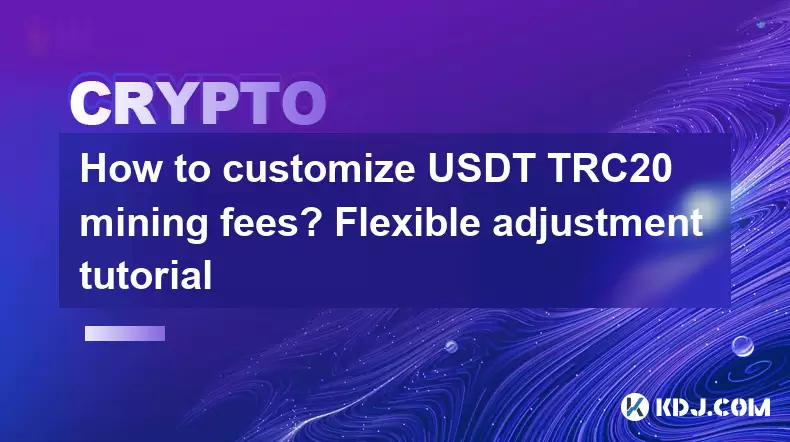
How to customize USDT TRC20 mining fees? Flexible adjustment tutorial
Jun 13,2025 at 01:42am
Understanding USDT TRC20 Mining FeesMining fees on the TRON (TRC20) network are essential for processing transactions. Unlike Bitcoin or Ethereum, where miners directly validate transactions, TRON uses a delegated proof-of-stake (DPoS) mechanism. However, users still need to pay bandwidth and energy fees, which are collectively referred to as 'mining fe...
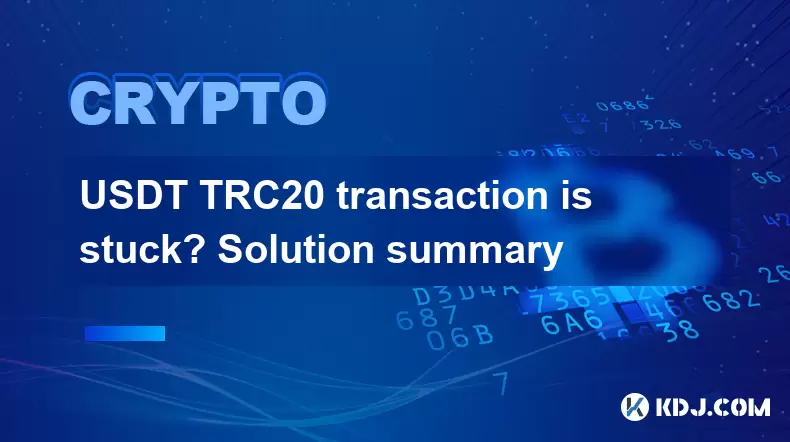
USDT TRC20 transaction is stuck? Solution summary
Jun 14,2025 at 11:15pm
Understanding USDT TRC20 TransactionsWhen users mention that a USDT TRC20 transaction is stuck, they typically refer to a situation where the transfer of Tether (USDT) on the TRON blockchain has not been confirmed for an extended period. This issue may arise due to various reasons such as network congestion, insufficient transaction fees, or wallet-rela...
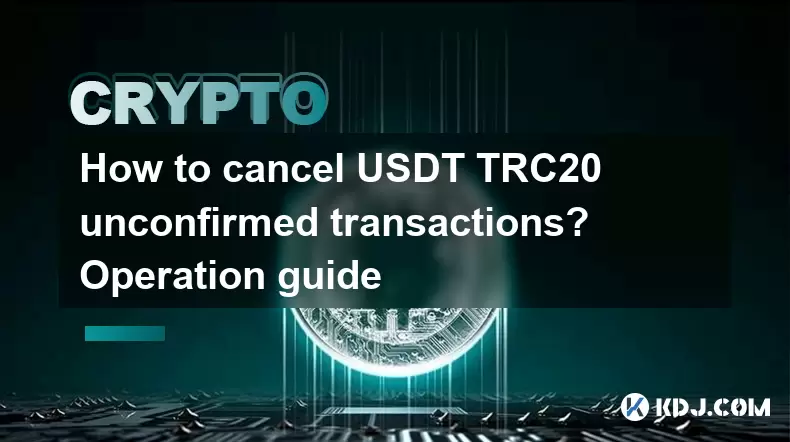
How to cancel USDT TRC20 unconfirmed transactions? Operation guide
Jun 13,2025 at 11:01pm
Understanding USDT TRC20 Unconfirmed TransactionsWhen dealing with USDT TRC20 transactions, it’s crucial to understand what an unconfirmed transaction means. An unconfirmed transaction is one that has been broadcasted to the blockchain network but hasn’t yet been included in a block. This typically occurs due to low transaction fees or network congestio...
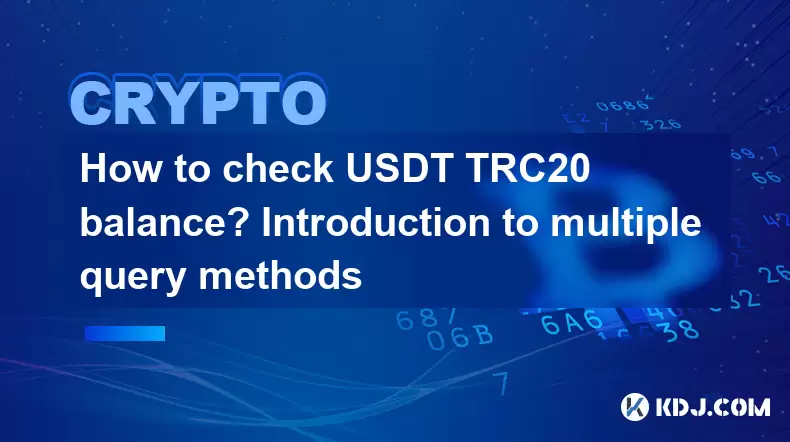
How to check USDT TRC20 balance? Introduction to multiple query methods
Jun 21,2025 at 02:42am
Understanding USDT TRC20 and Its ImportanceUSDT (Tether) is one of the most widely used stablecoins in the cryptocurrency market. It exists on multiple blockchain networks, including TRC20, which operates on the Tron (TRX) network. Checking your USDT TRC20 balance accurately is crucial for users who hold or transact with this asset. Whether you're sendi...

What to do if USDT TRC20 transfers are congested? Speed up trading skills
Jun 13,2025 at 09:56am
Understanding USDT TRC20 Transfer CongestionWhen transferring USDT TRC20, users may occasionally experience delays or congestion. This typically occurs due to network overload on the TRON blockchain, which hosts the TRC20 version of Tether. Unlike the ERC20 variant (which runs on Ethereum), TRC20 transactions are generally faster and cheaper, but during...
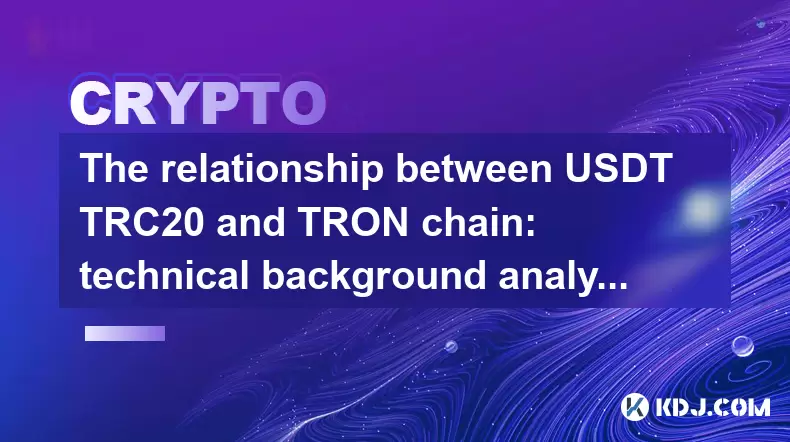
The relationship between USDT TRC20 and TRON chain: technical background analysis
Jun 12,2025 at 01:28pm
What is USDT TRC20?USDT TRC20 refers to the Tether (USDT) token issued on the TRON blockchain using the TRC-20 standard. Unlike the more commonly known ERC-20 version of USDT (which runs on Ethereum), the TRC-20 variant leverages the TRON network's infrastructure for faster and cheaper transactions. The emergence of this version came as part of Tether’s...

How to customize USDT TRC20 mining fees? Flexible adjustment tutorial
Jun 13,2025 at 01:42am
Understanding USDT TRC20 Mining FeesMining fees on the TRON (TRC20) network are essential for processing transactions. Unlike Bitcoin or Ethereum, where miners directly validate transactions, TRON uses a delegated proof-of-stake (DPoS) mechanism. However, users still need to pay bandwidth and energy fees, which are collectively referred to as 'mining fe...

USDT TRC20 transaction is stuck? Solution summary
Jun 14,2025 at 11:15pm
Understanding USDT TRC20 TransactionsWhen users mention that a USDT TRC20 transaction is stuck, they typically refer to a situation where the transfer of Tether (USDT) on the TRON blockchain has not been confirmed for an extended period. This issue may arise due to various reasons such as network congestion, insufficient transaction fees, or wallet-rela...

How to cancel USDT TRC20 unconfirmed transactions? Operation guide
Jun 13,2025 at 11:01pm
Understanding USDT TRC20 Unconfirmed TransactionsWhen dealing with USDT TRC20 transactions, it’s crucial to understand what an unconfirmed transaction means. An unconfirmed transaction is one that has been broadcasted to the blockchain network but hasn’t yet been included in a block. This typically occurs due to low transaction fees or network congestio...

How to check USDT TRC20 balance? Introduction to multiple query methods
Jun 21,2025 at 02:42am
Understanding USDT TRC20 and Its ImportanceUSDT (Tether) is one of the most widely used stablecoins in the cryptocurrency market. It exists on multiple blockchain networks, including TRC20, which operates on the Tron (TRX) network. Checking your USDT TRC20 balance accurately is crucial for users who hold or transact with this asset. Whether you're sendi...

What to do if USDT TRC20 transfers are congested? Speed up trading skills
Jun 13,2025 at 09:56am
Understanding USDT TRC20 Transfer CongestionWhen transferring USDT TRC20, users may occasionally experience delays or congestion. This typically occurs due to network overload on the TRON blockchain, which hosts the TRC20 version of Tether. Unlike the ERC20 variant (which runs on Ethereum), TRC20 transactions are generally faster and cheaper, but during...

The relationship between USDT TRC20 and TRON chain: technical background analysis
Jun 12,2025 at 01:28pm
What is USDT TRC20?USDT TRC20 refers to the Tether (USDT) token issued on the TRON blockchain using the TRC-20 standard. Unlike the more commonly known ERC-20 version of USDT (which runs on Ethereum), the TRC-20 variant leverages the TRON network's infrastructure for faster and cheaper transactions. The emergence of this version came as part of Tether’s...
See all articles

























